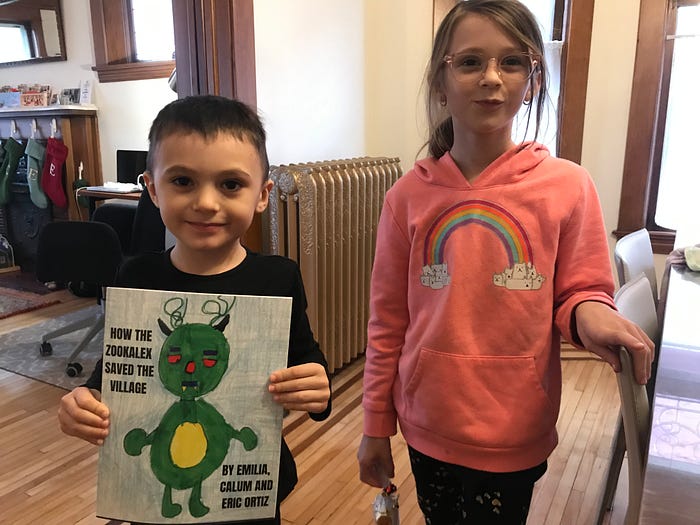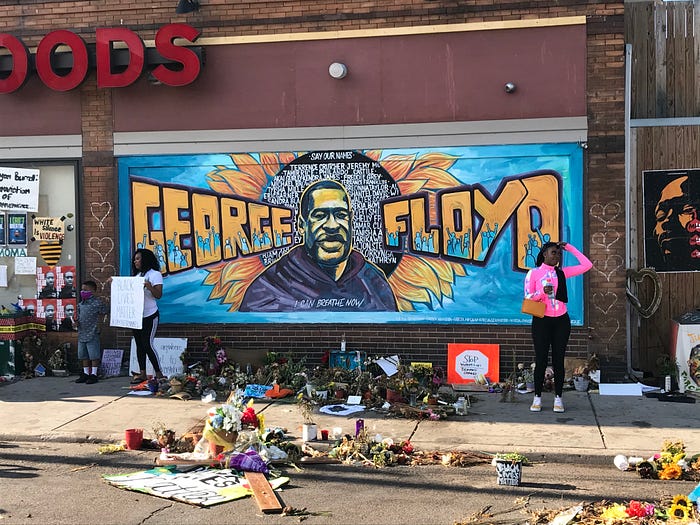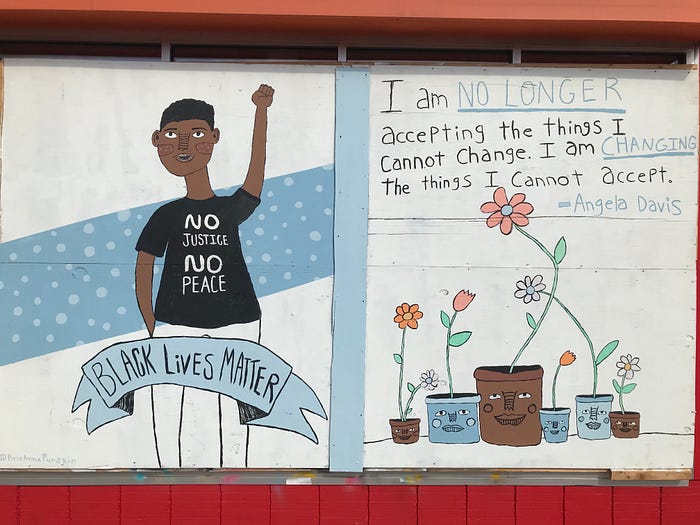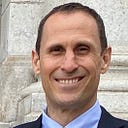How Many People Could One Children’s Book Help?

Homeschooling has been a learning experience. Not just for kids, but moms and dads, too. It’s called pandemic parenting, and as pandemic parents, we had to get creative at our house.
Homeschool started on Monday, March 16, 2020. That was the first day our three kids missed in-person school because of COVID-19. That also was the first day our kids, led by my wife, started a “Picture of the Day.” Each day they didn’t go to school because of the pandemic, our kids (ages 12, 8, and 5) drew a picture that we posted on our front door at the end of the day. The pictures featured images of dolphins, giraffes, unicorns, trees, hand sanitizer, and many other things. Some pictures included messages like “happy birthday,” “peace,” and “vote.”
The idea was to spread a little hope and joy in the Lowry Hill East neighborhood of our community in Minneapolis during some difficult times. We thought we would do this for a few weeks, maybe a month or two. We ended up doing a “Picture of the Day” for 358 days.

Homeschool ended on Tuesday, March 9, 2021. That was the last day our kids (now ages 6, 9, and almost 13) missed in-person school because of COVID-19. They returned to school in person on March 10, 2021. For anyone counting at home, homeschool lasted almost a year. Our kids drew 358 pandemic pictures — 1,074 pictures total. You can see every one of them on Instagram. Art taught our family a lot this year. And those pandemic pictures were just the beginning.
Not long after homeschool started, George Floyd died in police custody on Memorial Day at 38th Street and Chicago Avenue in Minneapolis. The site of his death turned into a memorial to honor Floyd’s life, and a group of community artists painted a mural of Floyd outside of Cup Foods, the market where Floyd was killed.

This mural became an iconic symbol of solidarity for protesters against racism, police brutality, and injustice. It was one of hundreds of murals that were painted across the Twin Cities to memorialize Floyd. The murals expressed a range of emotions: fear, anger, grief, disgust, courage, optimism, love. They also had messages that called for justice, equality, change, peace.
All of this hit close to home. George Floyd died a few blocks from our kids’ school, Risen Christ, and many murals were painted in Uptown not far from where we live. George Floyd Square is in the backyard of our kids’ school, and the tragedy affected everyone in our community.
But a pandemic and historic civil unrest were not in the parent handbook. So we had to figure out a plan. We want our kids to live in a better world than we do now. We don’t want what is occurring today to be their normal tomorrow. We want to help our kids understand what is happening in our city and community with compassion and empathy. How could we teach our kids about the injustice of racism? How could we explain the fear of law enforcement some people have because of the color of their skin or their immigration status?
I had an idea. Tell a story. We could use storytelling to put all of these heavy issues into a context that makes sense for kids. Together, we would write a children’s book. Had I ever written a children’s book? Not exactly. I had read a lot of children’s books. I had heard a lot of stories told to me since I was a kid. I had told my kids a lot of stories since they were born. I had studied storytelling since grammar school and understood the mechanics of the craft. I had written lots of stories as a journalist. I had wanted to write a children’s book since we had kids. I even had written fiction stories before, but none really since a creative writing class in college.
This idea was a bit of a leap of faith. But I’ve never lacked ambition, or (some might say) hardheadedness.
I started by recruiting the writing team. Our 12-year-old daughter wanted no part. She’s a pre-teen who had been in lockdown with her parents 24/7 for months. She didn’t want to do a project with her dad. It was understandable. Our 8-year-old daughter and 5-year-old son were in.
So the three of us started writing a story together. It was about a brave boy and a dragon who saved a kingdom. The boy questions why people are always fighting. Then he finds a way to save the village with the dragon. That’s the CliffsNotes version. Our writing process was a true collaboration. We would talk about the story, then I would type out our conversations into story form. Then, we would read together and revise until we got it to where we liked. This process took many weeks. We sensed we had a hit. We were excited to get some feedback, so we asked their mom/my wife to read it. After she read our story, she broke some bad news to us. “This story has already been written,” she said. It’s called “Boy,” a book by Phil Cummings that was published in 2017. Great book. We even have it in our children’s book collection.
Back to the drawing board. We didn’t have to do start over from scratch. But we had to make some major alterations to make our story to make it original. Not a problem. It was a blessing actually. It forced us to be more conscious of every aspect of our story and rethink everything — the beginning, middle, end, characters, character names, rising action, climax, resolution. It worked, and we created a new story called “How the Zookalex Saved the Village.” It is about building community and fairness. And this time, it was 100 percent original.

Now, we had to draw the pictures. All of the writing team became illustrators, and we drew pictures for the book. It took some time, and daily prodding from me with my collaborators. Days turned into more weeks. Can you draw the picture now? No, how about now? Not really, what about now? We finally finished all of the pictures for the book right around Thanksgiving. The plan was to turn it into a book using Shutterstock and give the books to our family as Christmas gifts. Not so fast said my wife. She wasn’t a big fan of spending money this way. That’s the suitable for work version. So I thought, why not publish the book ourselves and share it with the world.

I did a little research on self-publishing, found a free self-publishing tool, and learned how to use it. Next thing you know, we had a published book. It went live at the beginning of December, and we started selling copies. You can pick up yours today. Fifty percent of our book sales go to a community mentorship organization in North Minneapolis called Brothers EMpowered. It’s for a fundraising campaign I organized as a board member for the Lowry Hill East Neighborhood Association (LHENA). The other half of book sales go to my kids, the “Zookalex” book authors and illustrators. Both are worthy causes.
After the community mentorship fundraiser is complete, we will donate 50 percent of book sales to Risen Christ, our kids’ school, which is the only Catholic dual immersion school in Minnesota and provides a bilingual education (Spanish/English) to a diverse community of learners. Another worthy cause.

We want this book to give back to the community. We started a book tour (via video) to speak to students in pre-K to third grade. We read our story to students and then have a discussion centered around themes in the book: diversity, bullying, heroes. The goal is to start conversations with youngsters about serious topics and show the power of art and imagination. If you are interested in having us speak to a class, let us know. We want this book to inspire others to use their imagination to create art and help kids understand that anyone can create art. That art can be anything you want it to be. And that art can be inspiring.
A few weeks after publishing our book, my daughter and son made their first movie. They shot it, edited it on iMovie, and posted it on YouTube. It is called “The Mystery of the Fire King.”
The movie inspired their cousins in California to make their own movies. It’s true that creativity is contagious, and this was a beautiful thing to see. How many more kids could we inspire to be creative and use their imaginations? If all of them keep creating, maybe someday they could use their imaginations to create something that has never been seen before and provide a new perspective for the world.
That’s what some young Minneapolis filmmakers did with a recent video — a one-shot drone tour of Bryant Lake Bowl, a popular bowling alley and watering hole in south Minneapolis. Bryant Lake Bowl is an important place on Lake Street, where many businesses were destroyed or heavily damaged after the rioting that occurred in the summer following Floyd’s death. This drone video, which was shot by Jay Byrd Christensen and caught the eye of “Guardians of the Galaxy” filmmaker James Gunn, went viral after showing the world the uniqueness and vitality of a local business in Minneapolis. It also boosted the spirits of a local community that has had a tough year. And it was all the result of imagination.
The imagination is a powerful tool. Albert Einstein believed imagination is more important than knowledge. Imagination is why we have airplanes and computers and modern medicine. We want to keep encouraging kids to use their imagination to reach for the stars. It starts with pictures or a story or a movie. But those pictures and stories could lead to much bigger things like no poverty, no inequality, no injustice. Think that’s crazy? Remember, Catholic priest and former Jesuit John Dear reminds us, “abolitionists who imagined a world without slavery … were dismissed as unpatriotic revolutionaries, unrealistic idealists, and crazy lunatics.”
The way things are is not the way things always have to be. Great advances in human history started with an idea. Imagination is the first step to realize those ideas. It’s important to learn the value of imagination at a young age and never lose that spark. But today, as Dear recognizes, our culture of war has made it difficult to see a road to peace. That doesn’t mean we should stop dreaming of a better world — a world without war or violence or poverty.
We need to reclaim our imagination. We have to begin to dream again of new possibilities. We need to exercise our imaginations, and envision a new world, no matter how crazy others think we are.
Change starts with the imagination. Imagination is the starting point for progress. For anything to change, we first have to believe change is possible.
Can basic human needs (food, clothing, shelter) be met for all people? Can basic human rights (equality, freedom from discrimination, life, liberty, and the pursuit of happiness) be applied to everyone? Can we move from a system of injustice to a true system of justice for all? The answer to all of these questions depends on us. We need to keep pushing to see things in a new way, then work together (collaborate) to develop plans (practical plans) that can make these visions a reality.

Our world can be whatever we want it to be. A world without wars and bloodshed. A world without racism. A world with justice and peace.
Imagine that.
If you like this story, please click the clap button. If you would like to buy a copy of “How the Zookalex Saved the Village,” go here. Fifty percent of book sales will be donated to Brothers EMpowered, a community mentorship organization in North Minneapolis.
